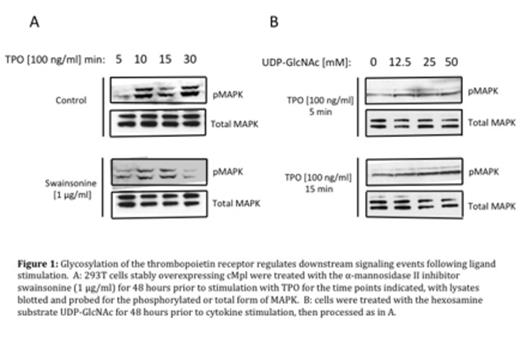Abstract
Thrombopoietin (TPO) is a key cytokine regulating hematopoietic stem cell (HSC) quiescence and self-renewal, and has been shown to augment ex vivo expansion and maintenance of HSCs in culture. Impaired TPO signaling is associated with bone marrow failure and thrombocytopenia. TPO mediates intracellular signal transduction by binding its cell surface receptor, cMpl, and transgenic mice deficient in cMpl expression have an age-progressive reduction in HSC content. An improved understanding of the mechanisms regulating HSC proliferation, self-renewal, and quiescence is essential to optimize transplantation, expansion, and other therapeutic applications of HSCs.
Posttranslational modification of proteins in the Golgi results in conjugation of complex-type N-glycans on glycoproteins destined for the cell surface. A complete deficiency of glycosylation results in failure of transport of proteins to the plasma membrane, while glycosylation with complex branched carbohydrates regulates a wide variety of functions at the cell surface including receptor clustering, cross-linking and trafficking. N-glycosylation of tyrosine kinase cytokine receptors has been shown to enhance their signaling potential by sparing receptor internalization via endocytosis, thus promoting receptor retention at the cell surface (Partridge EA et al, Science 2004). cMpl is known to undergo N-linked glycosylation, with defects in posttranslational processing associated with polycythemia vera. However, little is known about the functional significance of glycosylation of cMpl on TPO signaling and HSC function.
Here we show that glycosylation of cMpl regulates TPO signal transduction in an endocytosis-dependent manner, resulting in enhanced short-term engraftment in a mouse model of in utero hematopoietic cell transplantation (IUHCT).
293T cells stably overexpressing the TPO receptor cMpl were treated with either the α-mannosidase II inhibitor swainsonine (1 μg/ml) to inhibit complex N-glycan branching or the hexosamine biosynthetic pathway substrate UDP-GlcNAc (12.5 – 50 mM) to increase N-glycan production. Activation of signaling proteins was measured by immunoblotting and immunofluorescence studies. Clathrin- and caveolin-dependent endocytosis was inhibited by potassium depletion and nystatin treatment, respectively. The effect of posttranslational cMpl modification on donor cell engraftment was assessed in a murine model of IUHCT. Fetal liver from gestational day 14 Balb/c recipient fetuses were assessed for donor cell chimerism 48 hours after transplantation with 10e6 B6-GFP bone marrow cells with or without UDP-GlcNAc treatment.
Inhibition of N-linked glycosylation by swainsonine treatment resulted in reduced downstream signal transduction following TPO stimulation, with significantly decreased levels of phosphorylation of MAPK (Figure 1A). Pharmacologic disruption of endocytosis was found to ablate the effects of swainsonine treatment, with equivalent and robust activation of MAPK in swainsonine-treated and untreated cells. Upregulation of N-linked glycosylation by supplementation of the glycosylation pathway with UDP-GlcNAc treatment resulted in a dose-dependent increase in signaling following TPO stimulation, with increased levels of phosphorylation of MAPK (Figure 1B). Finally, UDP-GlcNAc treatment of donor cells resulted in significantly higher engraftment levels at 48 hours post IUHCT compared to controls (20.18 +/- 2.77 versus 30.27 +/- 1.985, p=0.0417).
These results support a role for cMpl glycosylation in modulating TPO signal transduction in an endocytosis-dependent manner, and suggest that enhanced cMpl glycosylation can optimize HSC function resulting in increased levels of engraftment following IUHCT. Ongoing studies of receptor trafficking, including internalization by clathrin-dependent and –independent endocytosis, are needed to further elucidate the functional significance of complex N-glycans on cMpl fate. These studies will ultimately improve our understanding of how TPO signaling may be manipulated to control HSC self-renewal and quiescence to optimize in vitro expansion and HSC transplantation.
No relevant conflicts of interest to declare.
Author notes
Asterisk with author names denotes non-ASH members.


This feature is available to Subscribers Only
Sign In or Create an Account Close Modal